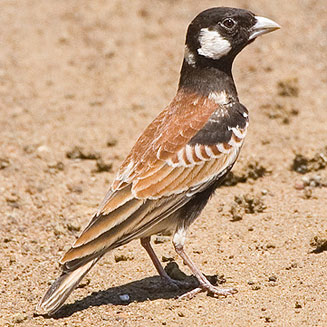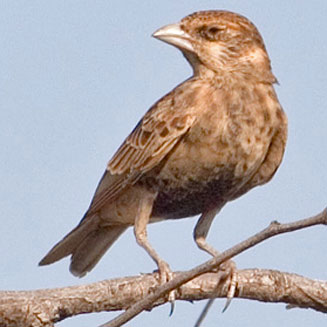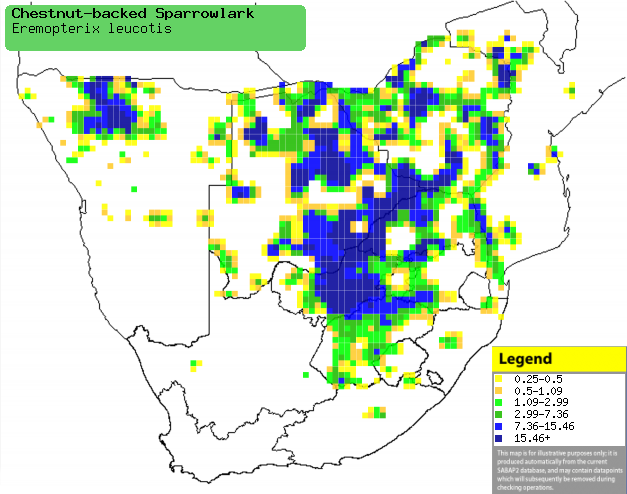|
Eremopterix leucotis
(Chestnut-backed sparrowlark, Chestnutbacked finchlark)
Rooiruglewerik [Afrikaans]; Ruruworo, Tjowe (generic terms
for sparrowlark and Pink-billed lark) [Kwangali]; ’Maliberoane, ’Mamphemphe
[South Sotho]; Bruinrug-vinkleeuwerik [Dutch]; Moinelette à oreillons
blancs [French]; Weißwangenlerche [German];
Cotovia-pardal-de-dorso-castanho [Portuguese]
Life
> Eukaryotes >
Opisthokonta
> Metazoa (animals) >
Bilateria >
Deuterostomia > Chordata >
Craniata > Vertebrata (vertebrates) > Gnathostomata (jawed
vertebrates) > Teleostomi (teleost fish) > Osteichthyes (bony fish) > Class:
Sarcopterygii (lobe-finned
fish) > Stegocephalia (terrestrial
vertebrates) > Tetrapoda
(four-legged vertebrates) > Reptiliomorpha > Amniota >
Reptilia (reptiles) >
Romeriida > Diapsida > Archosauromorpha > Archosauria >
Dinosauria
(dinosaurs) > Saurischia > Theropoda (bipedal predatory dinosaurs) >
Coelurosauria > Maniraptora > Aves
(birds) >
Order: Passeriformes > Family: Alaudidae
> Genus: Eremopterix
 |
 |
|
Chestnut-backed sparrowlark male. [photo
Neil Gray
©] |
Chestnut-backed sparrowlark female. [photo
Neil Gray
©] |
Distribution and habitat
Occurs in a band from Senegal to Ethiopia, with a separate
population from Malawi to southern Zambia, Angola and southern Africa. Here it
is locally common in short grassland and semi-arid savanna woodland, especially
in recently burnt areas; it may also occupy croplands, road verges, fallow
fields and airstrips.
|
 |
|
Distribution of Chestnut-backed sparrowlark in southern Africa,
based on statistical smoothing of the records from first SA Bird Atlas
Project (©
Animal Demography unit, University of
Cape Town; smoothing by Birgit Erni and Francesca Little). Colours range
from dark blue (most common) through to yellow (least common).
See here for the latest distribution
from the SABAP2. |
Food
It mainly eats seeds taken from cultivated cereal crops or
grasses, supplemented with invertebrates (especially during the breeding season).
It lives and forages in groups of 5-50 birds in the non-breeding season,
occasionally up to several hundred.
Breeding
- Both sexes build the nest, which is a cup of dry grass and rootlets placed
in a shallow excavated depression in the ground. It is often positioned
against a grass tuft or stone in recently fallowed agricultural land, with
clods of dirt or stones surrounding the entrance.
- Egg-laying season is year-round, varying from region to region.
Generally in arid areas (such as Botswana) it begins during rains in
January-March, where as in more moist regions (such as Zimbabwe and eastern
South Africa) it begins after rainfall from February-September (peaking from
March-July).
- It lays 1-3 eggs, which are incubated by both sexes for about 11 days,
with the female taking the night shift and the male helping her in the day.
- The chicks are brooded and fed by both parents, leaving the nest at
about 10-12 days old, before they are able to fly.
Threats
Not threatened, in fact it has adapted well to the
introduction of agriculture.
References
-
Hockey PAR, Dean WRJ and Ryan PG 2005. Roberts
- Birds of southern Africa, VIIth ed. The Trustees of the John Voelcker
Bird Book Fund, Cape Town.
|
